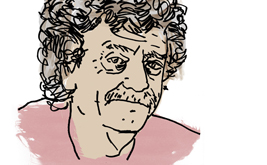
‘I Was There’: On Kurt Vonnegut ‘I Was There’: On Kurt Vonnegut
Kurt Vonnegut sought to fool us with his eyes wide open.
May 16, 2012 / Books & the Arts / William Deresiewicz
RNC Goes All In to Defend Wisconsin’s Walker, but Where’s the DNC? RNC Goes All In to Defend Wisconsin’s Walker, but Where’s the DNC?
More than 100,000 activists petition Democratic National Committee to match the massive commitment by GOP corporate interests to defend the anti-labor governor.
May 16, 2012 / John Nichols
Robert Scheer: How JP Morgan Chase Lost Its $2 Billion Gamble Robert Scheer: How JP Morgan Chase Lost Its $2 Billion Gamble
JP Morgan Chase’s recent $2 billion loss has intensified calls for financial regulation.
May 16, 2012 / Press Room
Puzzle No. 3240 Puzzle No. 3240
Don’t miss Kosman and Picciotto’s crossword blog, Word Salad.
May 15, 2012 / Joshua Kosman and Henri Picciotto
Letters Letters
They Speak Bornholmsk, Don’t They? Vancouver In his review of Norman Davies’s Vanished Kingdoms [“Shelf Life,” April 30], Thomas Meaney referred to the “island of Bornholm off the Danish coast, where the Burgundians may have established an early kingdom.” Actually, Bornholm is a Danish island off the Swedish coast, and it’s closer to the Polish and German coasts than to the Danish coast. ROBERT RENGER Abolitionists: First Human Rights Activists? Ypsilanti, Mich. In “Of Deserts & Promised Lands” [March 19], Samuel Moyn asserts that “abolitionists almost never used the idea of rights, activated as they were by Christianity, humanitarianism or other ideologies.” Moyn needs to read the American abolitionists to see how wrong this is. David Walker’s Appeal to the Colored Citizens of the World (1829) faults Jefferson for denying rights to slaves that he proclaimed for others. Walker, one of the most influential black abolitionists, also embraced Christianity, but his faith was not in conflict with his demand for full rights for the enslaved. Claiming equal rights was central to Walker. A few years after Walker’s Appeal, William Lloyd Garrison, the most influential white abolitionist, wrote the Declaration of Sentiments for the 1833 founding meeting of the American Anti-Slavery Society. It said, “The right to enjoy liberty is inalienable” and “Every man has a right to his own body—to the products of his own labor—to the protection of law—and to the common advantages of society.” The abolitionist movement was based on demanding equal rights. Abolitionists claimed equal rights for blacks and defined slavery as inherently a violation of rights. The abolitionists deserve credit for helping to create the very idea of universal human rights, even if their century lacked a system of international law in which to make their case. MARK D. HIGBEE Moyn Replies New York City It is well-known—and people are turning up more evidence today—that the language of rights was sometimes used by American abolitionists, especially during a brief period in the 1830s. The phrase “human rights” even served as the title of an abolitionist magazine. That doesn’t mean, of course, that it was the dominant framework for abolitionism, then or ever. And not only was the American story complex; it was just part of the vast story of the agitation against global slavery (in the British sphere, rights talk had less traction). In any event, as Mark Higbee correctly points out, the international law of the era never conferred rights, let alone “human rights,” on Africans, including in the episode Jenny Martinez recounts in her interesting book. SAMUEL MOYN Getting on the Good Side New York City In “Faces out of the Crowd,” his March 26 review of the Renaissance portrait show at the Met, Barry Schwabsky wonders why left-facing profiles are much more common than right-facing ones and calls it a “mystery” that this goes “unmentioned.” Would that the critic would try it himself! Had he done so, he might have noticed what most draftsmen know—and what the Renaissance art historian David Rosand observes in Drawing Acts about a group of profile drawings by the (left-handed) master Leonardo da Vinci: “All the heads face to the right, as we might expect of a left-handed draftsman: the natural way to draw a profile is from within, the hand moving inside the head, internally generating the curving contour outward, from the wrist.” More artists—more people—are right-handed; thus, they begin the contour from upper right, which results in a left-facing profile. DEBORAH ROSENTHAL
May 15, 2012 / Our Readers and Samuel Moyn
Romney’s Cowardly Speech on the Deficit Romney’s Cowardly Speech on the Deficit
Mitt says he will lead on debt reduction, but he avoids saying how.
May 15, 2012 / Ben Adler
Did Obama Endorse Gay Marriage for Political Reasons? Good. Did Obama Endorse Gay Marriage for Political Reasons? Good.
Many Americans think the president came out for gay marriage for political motivations. That could be a good thing.
May 15, 2012 / Ari Melber

Sherrod Brown Held Corporations Accountable, Now They’re Spending Millions to Unseat Him Sherrod Brown Held Corporations Accountable, Now They’re Spending Millions to Unseat Him
Senator Sherrod Brown has been a leader in taking on the big banks, and now the Chamber of Commerce is retaliating.
May 15, 2012 / Zaid Jilani
![Public vs Private Morality [VIDEO]](https://www.thenation.com/wp-content/uploads/2015/03/reich_morality_hp.jpg)
Public vs Private Morality [VIDEO] Public vs Private Morality [VIDEO]
The problem with America isn't what people do in their bedrooms but what they've been doing in boardrooms.
May 15, 2012 / Robert B. Reich
The Criminalization of Rape Victims The Criminalization of Rape Victims
There’s a growing trend of criminalizing rape survivors in order to guarantee their testimonies at trial.
May 15, 2012 / Salamishah Tillet
